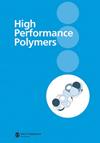含苯并恶唑结构的可溶性亚胺低聚物
IF 1.6
4区 化学
Q3 POLYMER SCIENCE
引用次数: 0
摘要
以4-苯基乙炔基邻苯二甲酸酐(4-PEPA)为封端剂,2-(4-氨基苯基)-5-氨基苯并恶唑(BOA)和3,4′-二氨基二苯醚(3,4′-ODA)为芳香族二胺,4,4′-(六氟异亚丙基)二苯甲酸酐(6FDA)作为芳香族二酐。采用傅立叶变换红外光谱(FTIR)、差示扫描量热法(DSC)、溶解度测试和流变学测量对酰亚胺低聚物进行了表征。然后通过苯乙炔基的热交联反应制备衍生自酰亚胺低聚物的热固性聚酰亚胺。使用热重分析(TGA)、动态机械热分析(DMA)和机械性能测量对热固性材料的热性能和机械性能进行了研究。系统地研究了酰亚胺低聚物的化学结构和分子量对其加工性能、热稳定性和力学性能的影响。结果表明,所有共聚酰亚胺低聚物均具有良好的有机溶解性和较低的熔体粘度,相应的热固性树脂在空气气氛中表现出高的玻璃化转变温度(高达401°C)和5%的失重温度(高至533°C),同时具有优异的机械性能(弯曲强度高达217MPa,断裂伸长率高达11.2%),PI-X-2(-O-,-BO-,-B-)的酰亚胺低聚物表现出较小的溶解度和较高的最小熔体粘度,但在固化后改善了玻璃化转变温度和它们的热固性材料的机械性能。本文章由计算机程序翻译,如有差异,请以英文原文为准。
Soluble imide oligomers containing benzoxazole structures
A series of soluble thermosetting polyimide resins containing benzoxazole structure were synthesized by two-step polymerization using 4-phenylethynylphthalic anhydride (4-PEPA) as the end-capping reagent, 2-(4-aminophenyl)-5-aminobenzoxazole (BOA) and 3,4′-diaminodiphenyl ether (3,4′-ODA) as the aromatic diamines, and 4,4′-(hexafluoroisopropylidene) diphthalic anhydride (6FDA) as the aromatic dianhydride. The imide oligomers were characterized by employing Fourier transform infrared spectroscopy (FTIR), differential scanning calorimetry (DSC), solubility tests and rheological measurements. Thermosetting polyimides derived from the imide oligomers were then produced via a thermal cross-linking reaction of the phenylethynyl group. The thermal and mechanical properties of the thermosets were studied using thermogravimetric analysis (TGA), dynamic mechanical thermal analysis (DMA), and mechanical property measurements. The effects of chemical architectures and molecular weights of the imide oligomers on processability, thermostability and mechanical properties were systematically investigated. The results showed that all the copolymerized imide oligomers possessed good solubility in organic and low melt viscosity, and the corresponding thermosets exhibited high glass transition temperature (up to 401°C) and 5% weight-loss temperature (up to 533°C) in an air atmosphere while excellent mechanical properties (flexural strength up to 217 MPa and elongation at break up to 11.2%). With the increase of the concentration of the benzoxazole group, the imide oligomers of PI-X-2 (-O-, -BO-, -B-) exhibited less solubility and higher minimum melt viscosity but improved glass transition temperature after curing and mechanical properties of their thermosets.
求助全文
通过发布文献求助,成功后即可免费获取论文全文。
去求助
来源期刊

High Performance Polymers
化学-高分子科学
CiteScore
4.20
自引率
14.30%
发文量
106
审稿时长
1.2 months
期刊介绍:
Health Services Management Research (HSMR) is an authoritative international peer-reviewed journal which publishes theoretically and empirically rigorous research on questions of enduring interest to health-care organizations and systems throughout the world. Examining the real issues confronting health services management, it provides an independent view and cutting edge evidence-based research to guide policy-making and management decision-making. HSMR aims to be a forum serving an international community of academics and researchers on the one hand and healthcare managers, executives, policymakers and clinicians and all health professionals on the other. HSMR wants to make a substantial contribution to both research and managerial practice, with particular emphasis placed on publishing studies which offer actionable findings and on promoting knowledge mobilisation toward theoretical advances. All papers are expected to be of interest and relevance to an international audience. HSMR aims at enhance communication between academics and practitioners concerned with developing, implementing, and analysing health management issues, reforms and innovations primarily in European health systems and in all countries with developed health systems. Papers can report research undertaken in a single country, but they need to locate and explain their findings in an international context, and in international literature.
 求助内容:
求助内容: 应助结果提醒方式:
应助结果提醒方式:


